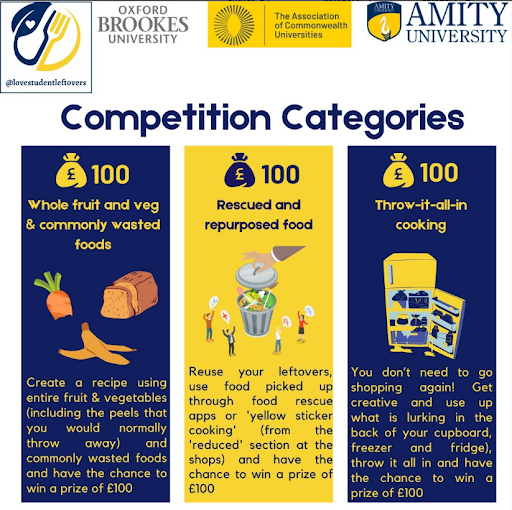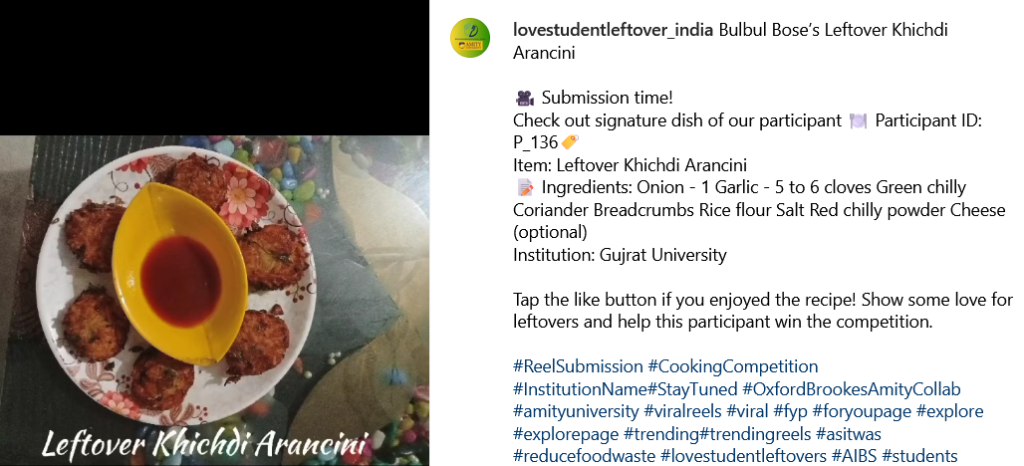The journey of food wastage in Indian kitchens
Post by Riya Gupta on behalf of Replenish
I’m a student from Madhya Pradesh, India, pursuing my master’s at Oxford Brookes Business School. Madhya Pradesh is a powerhouse in agriculture, significantly contributing to India’s farming economy. Yet amidst this abundance, millions of children are sererely underweight or experiencing stunted growth1. In parts of India it’s common to see people asking for food, which is ironic given that nearly a third of food produced is wasted globally2.

A student-led project on food wastage felt like the perfect chance to spread awareness, epecially among the youth. I’ve noticed a pattern in many Indian families, including my own, where cooking in excess has become a reflex, only to dispose of the leftovers the next day. Though the solution is simple — cook just enough and avoid waste.
Food waste in India versus the UK
Serving abundant food is sometimes associated with social status and prosperity in India. This can lead to excessive food preparation, especially during social gatherings, to showcase generosity and affluence. Food waste in the UK is less about social status and more related to consumer behaviour, such as the tendency to overbuy due to sales and discounts, as well as a lack of planning regarding food purchases and usage.
Among the general Indian populace there’s a gap in knowledge around the impact of food wastage and about preservation methods. Additionally, cultural norms and practices play a larger role in influencing food wastage habits. In the UK, consumers may be more aware of the environmental impact; the issue is more about changing habits formed in a consumerist society. Although there’s still a need for better education on food storage, expiry dates, and creative use of leftovers.
Strategies for change
India
- Improve infrastructure for storage and preservation
- Enhance awareness about the nutritional value of different food parts
- Change perceptions around leftovers and food safety
- Educate about portion control and meal planning
United Kingdom
- Advocate for supermarkets to relax aesthetic standards for produce
- Encourage food sharing and preservation technologies
- Reduce the stigma around leftovers
- Promote smarter shopping habits
While both countries face significant challenges with food wastage, the underlying causes and most effective solutions differ, reflecting broader cultural, economic, and infrastructural contexts.
The role of the ‘Love Student Leftovers‘ project

This digital cooking competition, part of an initiative by Oxford Brookes University (UK) and Amity University (India), turns the spotlight on food waste. Challenging students to whip up dishes that minimize waste sparks creativity, whilst serving as a hands-on lesson in sustainability. This contest isn’t just for show—it’s a call to action, inviting participants to rethink how they view and use food. It’s a direct response to the issues highlighted in our food wastage discussions, offering a practical, engaging way to make a difference.
There’s an interesting twist in how students choose their ingredients. At Amity, the focus is on whipping up something new with leftovers, showing a knack for giving yesterday’s meals a fresh spin.

Whereas at Oxford Brookes it’s about using up food in the pantry that’s close to expiring. This highlights how what’s considered surplus in one place might not be seen as waste in the other, and vice versa.

Despite this, it’s clear both groups of students are on a mission to tackle food waste head-on. They’re showing that no matter where we are in the world, we can all play a part in reducing food waste. It’s a shared goal that brings us together, highlighting the power of collaboration and innovation in making a difference.
It’s time for change – one meal at a time
It’s clear that the issue of food waste is deeply rooted in our habits, culture, and the systems we navigate daily. It’s more than just statistics and policies; it’s about how we value the food on our plates and the resources it represents. The journey from recognizing the problem to actively addressing it involves each one of us – from the choices we make at home, to the ways we engage with our communities and support policies that foster sustainability. This is an invitation to be part of a meaningful change, one meal at a time. The time to act is now!
Calling all students to take part!
The competition is a brilliant blend of education and action against food waste. It encourages students to become part of the solution in a very tangible, impactful way. It’s about turning the tide on food wastage, one creative dish at a time. There is still time to get involved, so get cooking this weekend.
For details of how to enter, head to the competition website or Instagram page and do share with family and friends. The competition closes at midnight on 25 March 2024.

Sources
For more tips on cooking and growing nutritious food with zero waste, sign up to our monthly newsletter.
good read
Have A Great Day Ahead – Melissa
Over 50 Delicious Keto Recipes – http://www.ketodietrecipes.co.uk
LikeLike